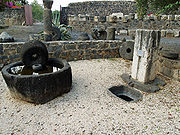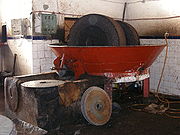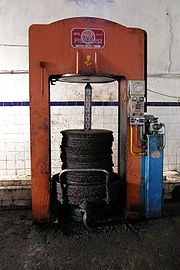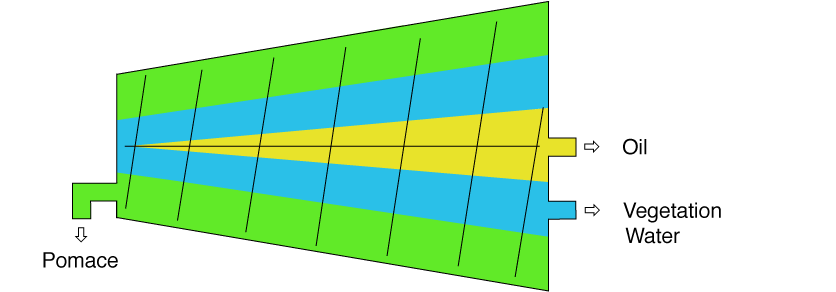
Olive oil extraction
Encyclopedia

Drupe
In botany, a drupe is a fruit in which an outer fleshy part surrounds a shell of hardened endocarp with a seed inside. These fruits develop from a single carpel, and mostly from flowers with superior ovaries...
s for food use. The oil is produced in the mesocarp cells
Plant cell
Plant cells are eukaryotic cells that differ in several key respects from the cells of other eukaryotic organisms. Their distinctive features include:...
, and stored in a particular type of vacuole
Vacuole
A vacuole is a membrane-bound organelle which is present in all plant and fungal cells and some protist, animal and bacterial cells. Vacuoles are essentially enclosed compartments which are filled with water containing inorganic and organic molecules including enzymes in solution, though in certain...
called a lipo vacuole, i.e., every cell contains a tiny olive oil droplet. Olive oil
Olive oil
Olive oil is an oil obtained from the olive , a traditional tree crop of the Mediterranean Basin. It is commonly used in cooking, cosmetics, pharmaceuticals, and soaps and as a fuel for traditional oil lamps...
extraction is the process of separating the oil
Oil
An oil is any substance that is liquid at ambient temperatures and does not mix with water but may mix with other oils and organic solvents. This general definition includes vegetable oils, volatile essential oils, petrochemical oils, and synthetic oils....
from the other fruit contents (vegetative extract liquid and solid material). It is possible to attain this separation by physical means alone, i.e., oil and water do not mix, so they are relatively easy to separate. This contrasts with other oils that are extracted with chemical solvents (generally hexane
Hexane
Hexane is a hydrocarbon with the chemical formula C6H14; that is, an alkane with six carbon atoms.The term may refer to any of four other structural isomers with that formula, or to a mixture of them. In the IUPAC nomenclature, however, hexane is the unbranched isomer ; the other four structures...
). The first operation when extracting olive oil is washing the olives, to reduce the presence of contaminants, especially soil
Soil contamination
Soil contamination or soil pollution is caused by the presence of xenobiotic chemicals or other alteration in the natural soil environment....
which can create a particular flavour defect called "soil taste".
Traditional method: olive press


Volubilis
Volubilis is an archaeological site in Morocco situated near Meknes between Fez and Rabat along the N13 road. The nearest town is Moulay Idriss. Volubilis features the best preserved Roman ruins in this part of northern Africa...
in Morocco
Morocco
Morocco , officially the Kingdom of Morocco , is a country located in North Africa. It has a population of more than 32 million and an area of 710,850 km², and also primarily administers the disputed region of the Western Sahara...
. An olive press works by applying pressure to olive paste to separate the liquid oil and vegetation water from the solid material. The oil and vegetation water are then separated by standard decantation
Decantation
Decantation is a process for the separation of mixtures. This is achieved by carefully pouring a solution from a container in order to leave the precipitate in the bottom of the original container...
.
This basic method is still widely used today, and it is still a valid way of producing high quality olive oil if adequate precautions are taken.
First the olives are ground into an olive paste using large millstone
Millstone
Millstones or mill stones are used in windmills and watermills, including tide mills, for grinding wheat or other grains.The type of stone most suitable for making millstones is a siliceous rock called burrstone , an open-textured, porous but tough, fine-grained sandstone, or a silicified,...
s. The olive paste generally stays under the stones for 30 to 40 minutes. This has three objectives:
- to guarantee that the olives are well ground
- to allow enough time for the olive drops to join to form the largest droplets of oil
- to allow the fruit enzymes to produce some of the oil aromas and taste
Rarely, olive oil mills use a modern crushing method with a traditional press.
After grinding, the olive paste is spread on fiber disks, which are stacked on top of each other, then placed into the press. Traditionally the disks were made of hemp or coconut fiber, but in modern times they are made of synthetic fibers which are easier to clean and maintain.
These disks are then put on a hydraulic piston, forming a pile. Pressure is applied on the disks, thus compacting the solid phase of the olive paste and percolating the liquid phases (oil and vegetation water). The applied hydraulic pressure can go to 400 atm
Atmosphere (unit)
The standard atmosphere is an international reference pressure defined as 101325 Pa and formerly used as unit of pressure. For practical purposes it has been replaced by the bar which is 105 Pa...
.
To facilitate separation of the liquid phases, water is run down the sides of the disks to increase the speed of percolation.
The liquids are then separated either by a standard process of decantation or by means of a faster vertical centrifuge
Centrifuge
A centrifuge is a piece of equipment, generally driven by an electric motor , that puts an object in rotation around a fixed axis, applying a force perpendicular to the axis...
.
The traditional method is a valid form of producing high quality olive oil, if after each extraction the disks are properly cleaned from the remains of paste; if not the leftover paste will begin to ferment, thereby producing inconsistencies of flavors (called defects) that will contaminate the subsequently produced olive oil.
A similar problem can affect the grindstones that, in order to assure perfect quality, also require cleaning after each usage.
Advantages and disadvantages
Proper cleaning produces higher quality oil. Grindstones, while ancient in design, are a suitable way to grind olives, because this method breaks up the drupeDrupe
In botany, a drupe is a fruit in which an outer fleshy part surrounds a shell of hardened endocarp with a seed inside. These fruits develop from a single carpel, and mostly from flowers with superior ovaries...
's pulp while only slightly touching the nut and the skin. This reduces the release of the oil oxidation
Rancidification
Rancidification is the chemical decomposition of fats, oils and other lipids . When these processes occur in food, undesirable odors and flavors can result. In some cases, however, the flavors can be desirable . In processed meats, these flavors are collectively known as "warmed over flavor"...
enzymes present in these organs.
In addition, in this extraction method, the introduction of water is minimal when compared to the modern one, thus reducing the washing-off of the polyphenol
Polyphenol
Polyphenols are a structural class of natural, synthetic, and semisynthetic organic chemicals characterized by the presence of large multiples of phenol structural units...
s.
The exhausted paste, called pomace
Pomace
Pomace , or marc , is the solid remains of grapes, olives, or other fruit after pressing for juice or oil. It contains the skins, pulp, seeds, and stems of the fruit....
, has a low content of water making it an easier residue to manage.
Advantages
- Better grinding of the olives, reducing the release of oil oxidationRancidificationRancidification is the chemical decomposition of fats, oils and other lipids . When these processes occur in food, undesirable odors and flavors can result. In some cases, however, the flavors can be desirable . In processed meats, these flavors are collectively known as "warmed over flavor"...
enzymes - Reduced added water, minimizing the washing of polyphenols
- Pomace with a low content of water easier to manage
Disadvantages
- Difficult cleaning
- Non-continuous process with waiting periods thus exposing the olive paste to the action of oxygenOxygenOxygen is the element with atomic number 8 and represented by the symbol O. Its name derives from the Greek roots ὀξύς and -γενής , because at the time of naming, it was mistakenly thought that all acids required oxygen in their composition...
and light. - Requires more manual labour
- Longer time period from harvest to pressing
Modern method: decanter centrifugation
The modern method of olive oil extraction uses an industrial decanter to separate all the phases by centrifugationCentrifugation
Centrifugation is a process that involves the use of the centrifugal force for the sedimentation of mixtures with a centrifuge, used in industry and in laboratory settings. More-dense components of the mixture migrate away from the axis of the centrifuge, while less-dense components of the mixture...
. In this method the olives are crushed to a fine paste. This can be done by a hammer crusher, disc crusher, depitting machine or knife crusher. This paste is then malaxed
Malaxation
Malaxation, a stage in olive oil extraction, is the action of slowly churning or mixing milled olives, typically for 20 to 40 minutes. The churning allows the smaller droplets of oil released by the milling process to aggregate and be more easily separated. The paste is normally heated to around...
for 30 to 60 minutes in order to allow the small olive droplets to agglomerate. The aromas are created in these two steps through the action of fruit enzyme
Enzyme
Enzymes are proteins that catalyze chemical reactions. In enzymatic reactions, the molecules at the beginning of the process, called substrates, are converted into different molecules, called products. Almost all chemical reactions in a biological cell need enzymes in order to occur at rates...
s.
Afterwards the paste is pumped in to an industrial decanter where the phases will be separated. Water is added to facilitate the extraction process with the paste.
The decanter is a large capacity horizontal centrifuge
Centrifuge
A centrifuge is a piece of equipment, generally driven by an electric motor , that puts an object in rotation around a fixed axis, applying a force perpendicular to the axis...
rotating approximately 3000 rpm
Revolutions per minute
Revolutions per minute is a measure of the frequency of a rotation. It annotates the number of full rotations completed in one minute around a fixed axis...
, the high centrifugal force
Centrifugal force
Centrifugal force can generally be any force directed outward relative to some origin. More particularly, in classical mechanics, the centrifugal force is an outward force which arises when describing the motion of objects in a rotating reference frame...
created allows the phases to be readily separated according to their different densities (solids > vegetation water > oil). Inside the decanter's rotating conical drum there is a coil that rotates a few rpm slower, pushing the solid materials out of the system.

Revolutions per minute
Revolutions per minute is a measure of the frequency of a rotation. It annotates the number of full rotations completed in one minute around a fixed axis...
that will separate the small quantity of vegetation water still contained in oil and vice versa.
Three, two, and two and a half phases decanters
With the three phases oil decanter, a portion of the oil polyphenols is washed out due to the higher quantity of added water (when compared to the traditional method), producing a larger quantity of vegetation water that needs to be processed.The two phases oil decanter was created as an attempt to solve these problems. Sacrificing part of its extraction capability, it uses less added water thus reducing the phenol washing. The olive paste is separated into two phases: oil and wet pomace. This type of decanter, instead of having three exits (oil, water and solids), has only two. The water is expelled by the decanter coil together with the pomace, resulting in a wetter pomace that is much harder to process industrially. Many pomace oil extraction facilities refuse to work with these materials because the energy costs of drying the pomace for the hexane oil extraction often make the extraction process sub-economical. In practice, then, the two phases decanter solves the phenol washing problem but increases the residue management problem. This residue management problem has been reduced by the collection of this wetter pomace and being transported to specialized facilities called extractors which heat the pomace between 45ºc and 50ºc and can extract up to a further 2 litres per 100 kilos of pomace using adapted two phase decanters.
The two and a half phases oil decanter is a compromise between the two previous types of decanters. It separates the olive paste into the standard three phases, but has a smaller need for added water and also a smaller vegetation water output. Therefore the water content of the obtained pomace comes very close to that of the standard three phases decanter, and the vegetation water output is relatively small, minimizing the residue management issues.
Advantages and disadvantages
Advantages- Compact machinery - one decanter can take the place of several presses
- Continuous and automated
- Limited labor required
- Highest percent of oil extraction
- Vegetable water disposal less of a problem
- Olive oil from two-phase centrifugation systems contains more phenols, tocopherols, trans-2-hexenal and total aroma compounds and is more resistant to oxidation than oil from three-phase ones and from hydraulic presses
Disadvantages
- Expensive
- More technical labor required
- High energy consumption
- Pomace may end up moist
- Greater amount of vegetable water to be disposed of
- Reduced antioxidants due to added water
- Subject to wear from rocks, grit
Sinolea
The Sinolea method to extract oil from the olives was introduced in 1972; in this process, rows of metal discs or plates are dipped into the paste; the oil preferentially wets and sticks to the metal and is removed with scrapers in a continuous process. It’s based on the different surface tensionSurface tension
Surface tension is a property of the surface of a liquid that allows it to resist an external force. It is revealed, for example, in floating of some objects on the surface of water, even though they are denser than water, and in the ability of some insects to run on the water surface...
of the vegetation water and the oil, these different physical behaviors allow the olive oil to adhere to a steel plaque while the other two phases stay behind.
Sinolea works by continuously introducing several hundreds of steel plaques in to the paste thus extracting the olive oil. This process is not completely efficient leaving a large quantity of oil still in the paste, so the remaining paste has to be processed by the standard modern method (industrial decanter).
Advantages and disadvantages
Advantages- Higher polyphenol content of oil
- Low temperature method
- Automated
- Low labor
- Oil/water separation step is not needed
- Low energy requirement
Disadvantages
- Often must be combined with one of the above methods in order to maximize oil extraction which requires more space and labor.
- Large surface areas can lead to rapid oxidation of the olive product
- Sale of future machines currently outlawed in the European UnionEuropean UnionThe European Union is an economic and political union of 27 independent member states which are located primarily in Europe. The EU traces its origins from the European Coal and Steel Community and the European Economic Community , formed by six countries in 1958...
due to difficulty in cleaning large surface areas.
First cold pressed – cold extraction
Many oils are marketed as first cold pressed or cold extraction, this is a denomination describing the temperature at which the oil was obtained.In the EU these designations are regulated by article 5 of Commission Regulation (EC) No 1019/2002 of 13 June 2002 on marketing standards for olive oil. This article states that in order to use these designations the olive oil bottler must prove that the temperature of malaxation
Malaxation
Malaxation, a stage in olive oil extraction, is the action of slowly churning or mixing milled olives, typically for 20 to 40 minutes. The churning allows the smaller droplets of oil released by the milling process to aggregate and be more easily separated. The paste is normally heated to around...
and extraction was under 27 °C (80 °F).
For olive oil bottled outside EU countries this regulation does not apply, and thus the consumer has no assurance that these statements are true.
The temperature of malaxation and extraction is crucial due to its effect on olive oil quality. When high temperatures are applied the more volatile aromas are lost and the rate of oil oxidation is increased, producing therefore lower quality oils. In addition, the chemical content of the polyphenols, antioxidants
Polyphenol antioxidant
A polyphenol antioxidant is a type of antioxidant containing a polyphenolic substructure. Numbering over 4,000 distinct species, many of these compounds have antioxidant activity in vitro but are unlikely to have antioxidant roles in vivo...
, and vitamin
Vitamin
A vitamin is an organic compound required as a nutrient in tiny amounts by an organism. In other words, an organic chemical compound is called a vitamin when it cannot be synthesized in sufficient quantities by an organism, and must be obtained from the diet. Thus, the term is conditional both on...
s present in the oil is reduced by higher temperatures. The temperature is adjusted basically by controlling the temperature of the water added during these two steps. High temperatures are used to increase the yield of olive oil obtained from the paste.
Alternative configurations
Some producers, in order to maximise product quality, choose to combine the traditional grinding method, the stone mill, with a modern decanterDecanter
A decanter is a vessel that is used to hold the decantation of a liquid which may contain sediment. Decanters are normally used as serving vessels for wine. Decanters vary in shape and design. They are usually made of an inert material and will hold at least one standard bottle of wine...
. This technique produces more selective grinding of the olives, reduces the malaxation time olive paste, and avoids the complicated cleaning of the olive press fibre disks. Because the use of the stone mill requires a loading and unloading phase, this extraction method is discontinuous, i.e., there are times when all the machinery is stopped, therefore it is generally not used on a large commercial scale, being applied only by small scale olive mills producing high quality olive oil.
Consumer point of view
High quality olive oil can be obtained by all the methods if proper measures are taken. Olive oil quality is equally dependent on the quality of the olives themselves and on the time they have to wait from harvesting to extraction, in addition to the extraction method itself.The two worst “enemies” of olive oil are oxygen and light. Once an olive is harvested, it should be pressed within 24 hours. Oxidation begins immediately upon harvesting. In the period between harvest and grinding, the fruits' enzymes are very active and increasingly degrade the endogenous
Endogenous
Endogenous substances are those that originate from within an organism, tissue, or cell. Endogenous retroviruses are caused by ancient infections of germ cells in humans, mammals and other vertebrates...
oil, and therefore oil obtained after a longer wait is of lower quality, presenting higher acidity (oleic acid
Oleic acid
Oleic acid is a monounsaturated omega-9 fatty acid found in various animal and vegetable fats. It has the formula CH37CH=CH7COOH. It is an odorless, colourless oil, although commercial samples may be yellowish. The trans isomer of oleic acid is called elaidic acid...
percentage).
In addition, if additional oxygen is allowed to interact with the olive paste during the extraction process, the acidity level will increase further. Sealed extraction methods are best to prevent the continued introduction of oxygen, as well as light to the oil.
After extraction is complete, in most cases the oil has a cloudy form, mainly due to the presence of minute amounts of water. This type of oil is called cloudy olive oil
Cloudy olive oil
Cloudy olive oil is an intermediate product of olive oil extraction. It is actually the initial cloudy juice of the olive drupes soon after crushing, separation and decanting and before final filtration...
, or veiled olive oil.
It is common practice that olive oil, or more specifically cloudy olive oil
Cloudy olive oil
Cloudy olive oil is an intermediate product of olive oil extraction. It is actually the initial cloudy juice of the olive drupes soon after crushing, separation and decanting and before final filtration...
, is stored in cool stainless steel silos with a conical bottom that are pumped free of oxygen. This will ensure the complete precipitation and separation of the two phases and additionally facilate the final stage in olive production, filtration
Filtration
Filtration is commonly the mechanical or physical operation which is used for the separation of solids from fluids by interposing a medium through which only the fluid can pass...
; it will also contribute in the integrity and stability of the oil.
Future prospects
The future of olive extraction points to reducing the negative aspects of the present methods, decreasing the degradation oil produced by the extraction process in itself.- Reducing the oxidation by performing part of the process of malaxation and the extraction under a controlled nitrogenNitrogenNitrogen is a chemical element that has the symbol N, atomic number of 7 and atomic mass 14.00674 u. Elemental nitrogen is a colorless, odorless, tasteless, and mostly inert diatomic gas at standard conditions, constituting 78.08% by volume of Earth's atmosphere...
atmosphere - Extracting the nut of the olive before grinding, this will reduce the release of oxidative enzymes present in this organ, and yield a pomacePomacePomace , or marc , is the solid remains of grapes, olives, or other fruit after pressing for juice or oil. It contains the skins, pulp, seeds, and stems of the fruit....
that is free from wood residues, making it possible to be used in animal feeding - Reducing the addition of water to minimize the washing of polyphenols
- Improving the sinolea method, through an increase in the efficiency of the adsorptionAdsorptionAdsorption is the adhesion of atoms, ions, biomolecules or molecules of gas, liquid, or dissolved solids to a surface. This process creates a film of the adsorbate on the surface of the adsorbent. It differs from absorption, in which a fluid permeates or is dissolved by a liquid or solid...
of the oil to the plates, thus reducing the need for the use of standard methods of extraction
See also
- Olive oilOlive oilOlive oil is an oil obtained from the olive , a traditional tree crop of the Mediterranean Basin. It is commonly used in cooking, cosmetics, pharmaceuticals, and soaps and as a fuel for traditional oil lamps...
- AmurcaAmurcaAmurca is the bitter tasting, dark watery liquid which flows from pressed olives under light pressure, prior to the olive oil which only drains under greater pressure. Historically, amurca was used for numerous purposes, including as a building material, pesticide, herbicide, and even as an...
, a byproduct in olive oil extraction, historically used for many purposes - Olive mill pomace composting Producción ecológica. Consejeria de Agricultura y Pesca Junta de Andalucía.España
External links
- Commission Regulation (EC) No 1019/2002 of 13 June 2002 on marketing standards for olive oil
- http://www.oilmillmachinerysuppliers.com/ Get complete technical information on Oil Processing, Oil Extraction, Seed Processing, Oil Refining, Oil Filtering, Seed Extraction and more @ http://www.oilmillmachinerysuppliers.com/

